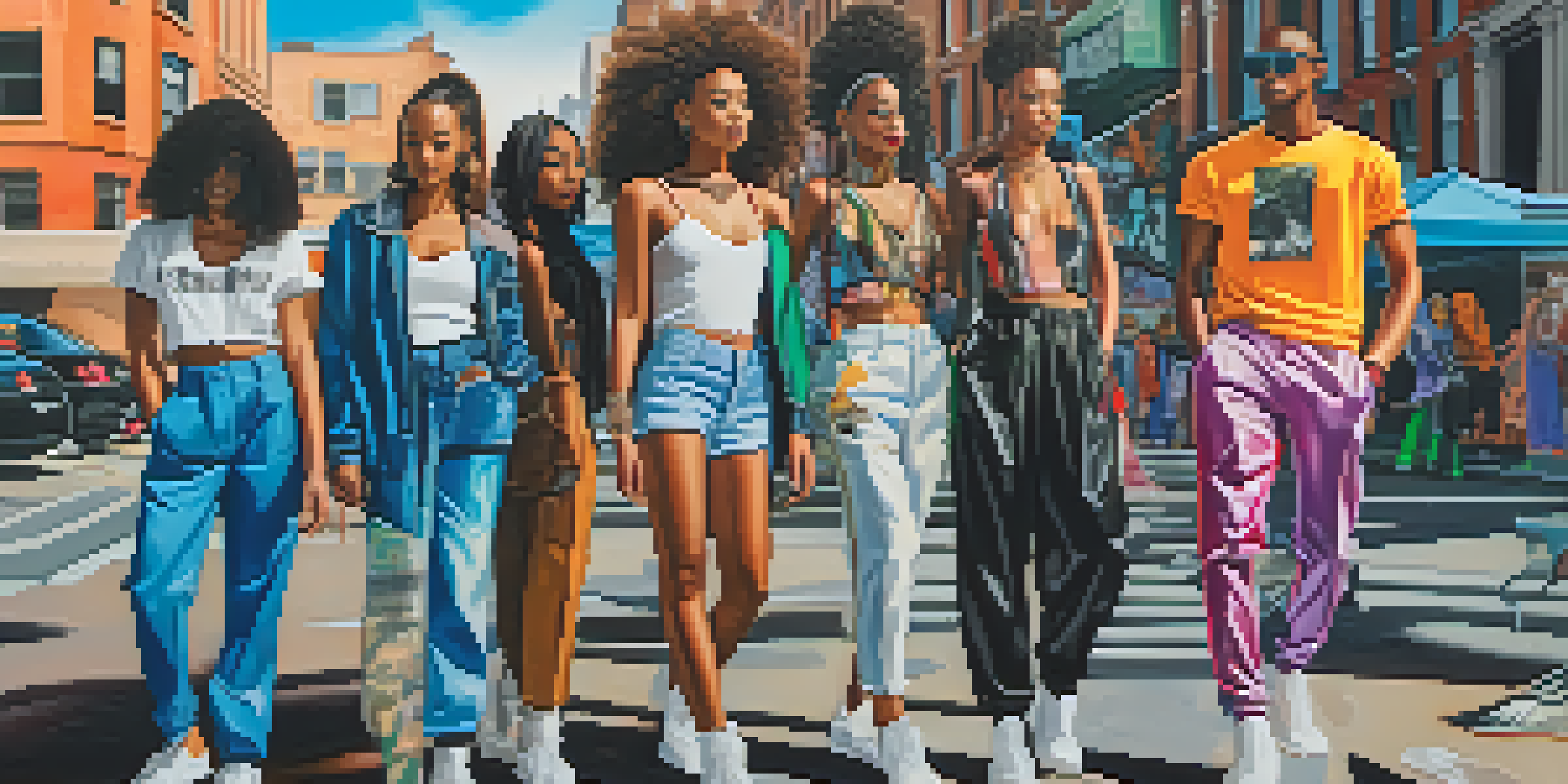The Impact of Fashion Collaborations on Brand Identity Growth

Understanding Fashion Collaborations and Their Purpose
Fashion collaborations occur when two or more brands come together to create a unique product or collection. This partnership can combine different styles, aesthetics, or values to attract a wider audience. For example, when a luxury brand collaborates with a streetwear label, it often results in a fresh take on both brands, appealing to diverse consumer demographics.
Collaboration is the new competition.
The primary purpose behind these collaborations is to leverage each brand's strengths while creating something innovative. By joining forces, brands can tap into each other's customer bases, expanding their reach and enhancing visibility. This is particularly important in a saturated market where standing out is crucial.
Moreover, collaborations can generate buzz and excitement, creating an air of exclusivity around the new offerings. Consumers often feel a sense of urgency to purchase these limited-edition items, driving sales and increasing brand loyalty.
Building Brand Identity Through Collaboration
Brand identity is the collection of perceptions and emotions that people associate with a brand. Collaborations can significantly influence this identity by introducing new elements that resonate with consumers. For instance, when a high-end fashion brand teams up with a popular influencer, it can shift public perception and modernize its image.

Through collaborations, brands can communicate their values in fresh and engaging ways. For example, a sustainable fashion label partnering with an eco-conscious celebrity can strengthen its commitment to environmental issues while attracting like-minded consumers. This alignment not only enhances brand identity but also fosters deeper connections with customers.
Collaborations Enhance Brand Identity
Fashion collaborations effectively merge unique strengths and aesthetics, allowing brands to expand their reach and attract new audiences.
Additionally, successful collaborations often lead to memorable storytelling opportunities. Brands can share behind-the-scenes content or narrative-driven campaigns that highlight the collaboration's inspiration, further enriching their identity and creating a more relatable brand image.
The Role of Social Media in Fashion Collaborations
In today's digital age, social media plays a pivotal role in amplifying the impact of fashion collaborations. Platforms like Instagram and TikTok allow brands to showcase their partnerships to a global audience instantly. This visibility can create significant buzz around a collaboration, leading to increased interest and sales.
Alone we can do so little; together we can do so much.
Social media also enables brands to engage directly with consumers, creating a two-way conversation about the collaboration. Brands can encourage user-generated content, where fans share their experiences with the new products, further enhancing visibility and brand loyalty. This interaction helps solidify the collaboration's success in the public eye.
Moreover, influencers and fashion icons can help spread the word about collaborations, serving as catalysts for brand awareness. When an influencer shares their excitement about a new collection, it can lead to a ripple effect, encouraging their followers to explore the brands involved.
Case Studies: Successful Fashion Collaborations
One of the most notable examples of a successful fashion collaboration is the partnership between Adidas and Kanye West. The Yeezy line transformed Adidas’ brand identity, appealing to both sneaker enthusiasts and casual consumers. This collaboration not only boosted sales but also positioned Adidas as a trendsetter in the footwear market.
Another great example is the collaboration between H&M and designer Karl Lagerfeld. This partnership made high-fashion more accessible, creating excitement among consumers and leading to long lines outside stores on launch day. The collaboration elevated H&M's brand identity as a retailer that offers stylish yet affordable fashion.
Social Media Amplifies Collaboration Buzz
Platforms like Instagram and TikTok play a crucial role in increasing visibility and engagement around fashion collaborations.
These case studies illustrate how effective collaborations can create a lasting impact on brand identity. By aligning with influential figures or brands, companies can redefine their image and attract new customer segments.
Challenges Faced in Fashion Collaborations
While fashion collaborations can be incredibly beneficial, they also come with their own set of challenges. One major risk is the potential for brand misalignment, where the collaborating brands do not resonate well together. This misalignment can lead to confusion among consumers and dilute the brand identity of both parties involved.
Another challenge is maintaining quality control. When multiple brands are involved, there can be discrepancies in product quality or design vision, leading to dissatisfaction among consumers. Brands must communicate effectively and establish clear expectations to avoid these pitfalls.
Lastly, managing consumer expectations can be tricky. When collaborations generate significant hype, there's a risk that the final product may not meet the lofty expectations set during the marketing phase. Brands must balance excitement with authenticity to ensure a positive reception.
The Future of Fashion Collaborations
As the fashion industry evolves, so too will the nature of collaborations. We can expect to see more interdisciplinary partnerships, where fashion brands collaborate with tech companies, artists, or even environmental organizations. These unique combinations can lead to innovative products that resonate with consumers in new ways.
Furthermore, the rise of virtual and augmented reality may influence how collaborations are marketed and experienced. Imagine trying on a limited-edition collection through a virtual fitting room before it hits the shelves. Such advancements could create new and exciting shopping experiences for consumers.
Challenges in Collaboration Management
Maintaining quality control and managing consumer expectations are vital challenges that brands must navigate during collaborations.
Ultimately, the future of fashion collaborations will likely focus on authenticity and inclusivity. Brands that prioritize genuine partnerships and reflect diverse voices in their collaborations will resonate more strongly with consumers, ensuring sustained growth in brand identity.
Key Takeaways on Collaboration Impact
Fashion collaborations can significantly enhance brand identity growth by merging unique strengths and aesthetics. These partnerships allow brands to expand their reach, attract new audiences, and create memorable experiences. By leveraging social media and influencer marketing, collaborations can generate buzz and foster deeper connections with consumers.
However, brands must navigate challenges such as maintaining quality, managing expectations, and ensuring alignment. Successful collaborations are built on clear communication, shared values, and a commitment to delivering exceptional products.

Looking ahead, the future of fashion collaborations is bright, with opportunities for innovation and inclusivity. Brands that embrace these trends and prioritize genuine partnerships will likely thrive in an ever-evolving fashion landscape.